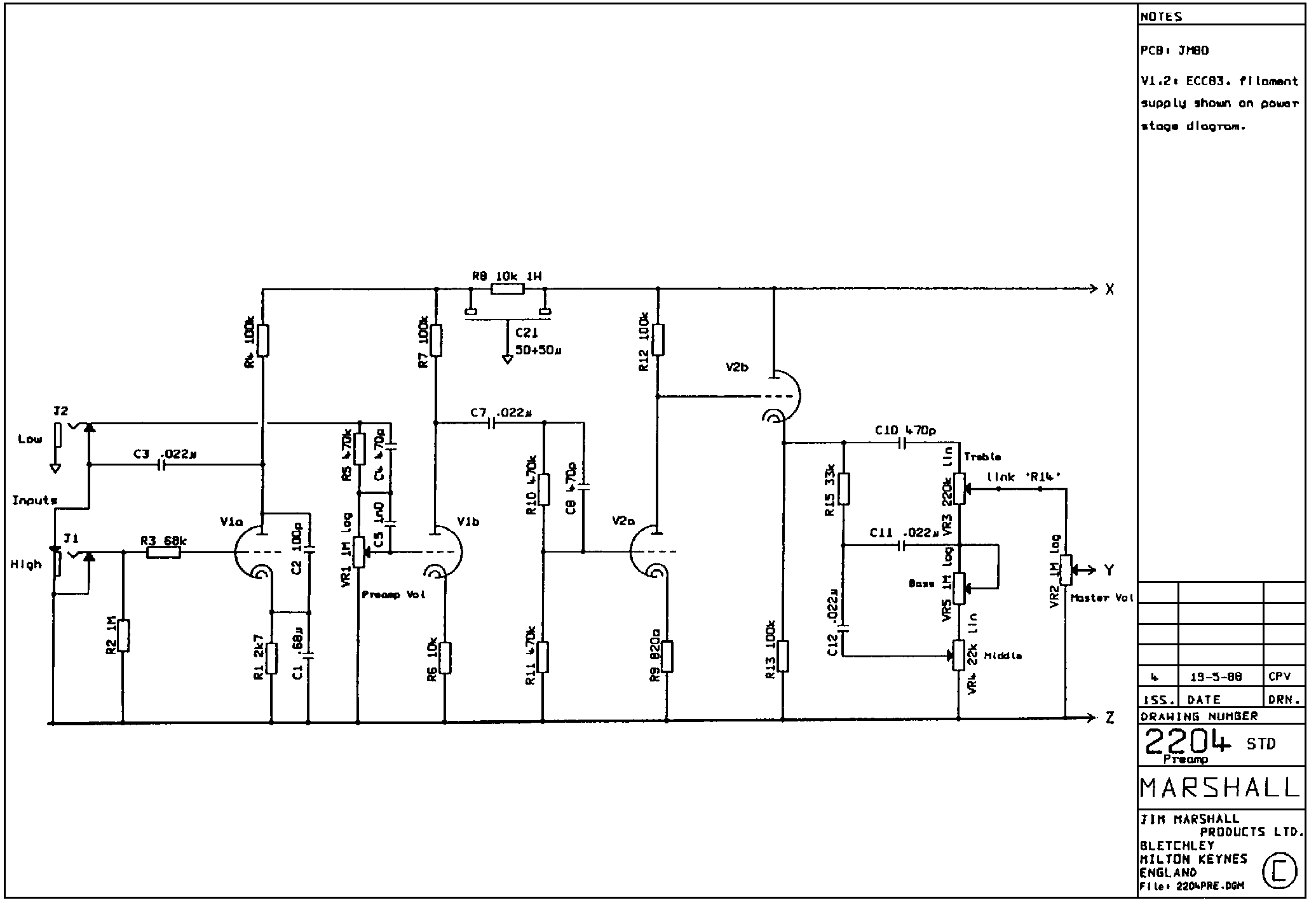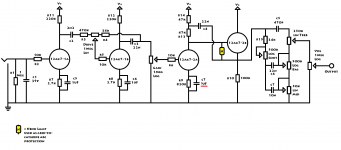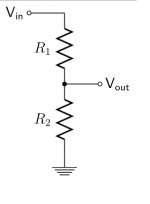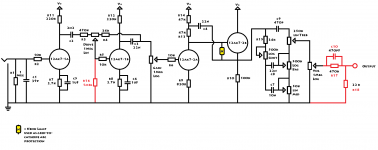Hello,
For the last 6 months or so i've been reading up a lot on amp building.
At some point in my life i went to the dark side (digital preamp).
And now i want a Tube Preamp, but instead of buying it, I wanna build it.
after have spending ages on sites like valvewizard.co.uk.
I think I'm ready for my first build.
i'd like your opinion on some points.
1 - I'm aiming for a high gain metal sound, is that likey with this schematic?
2 - Are there any flaws in it?
3 - Are there some extra safety features that could be added?
All other comments/info is also very welcome
Thanks ~ Paul
For the last 6 months or so i've been reading up a lot on amp building.
At some point in my life i went to the dark side (digital preamp).
And now i want a Tube Preamp, but instead of buying it, I wanna build it.
after have spending ages on sites like valvewizard.co.uk.
I think I'm ready for my first build.
i'd like your opinion on some points.
1 - I'm aiming for a high gain metal sound, is that likey with this schematic?
2 - Are there any flaws in it?
3 - Are there some extra safety features that could be added?
All other comments/info is also very welcome
Thanks ~ Paul
Attachments
My favorite preamp is from the Marshall Valvestate 8100.
I had one of these amps and it got stolen, So I plan on just building the preamp section.
Orginaly I had blown the power amp and I just used the line out to my bigger rack mount amps and I still got that Incredibly Awesome sound from it!!
It is a very simple and cheap circuit to use since it is a opamp based and uses just one 12AX7.
If you still want an all tube version that I would take a look at the Marshall scematic's like the TSL series or the 2000AVT series for the nice extreme metal sound.
I played on the all tube TSL 2000 AVT when it came out in 2000 and I was just in Love with that amp but I couldn't foot the $1400 price for it.
All of those schematics can be found on line, If I had more tubes laying around I would be building one of those AVT types but I only have a few left in my parts bin and for me the 8100 Valvestae would suit me just fine.
I loved that amp, and building just the preamp would be cheaper than replacing the whole head itself.
Cheers !!
jer 🙂
I had one of these amps and it got stolen, So I plan on just building the preamp section.
Orginaly I had blown the power amp and I just used the line out to my bigger rack mount amps and I still got that Incredibly Awesome sound from it!!
It is a very simple and cheap circuit to use since it is a opamp based and uses just one 12AX7.
If you still want an all tube version that I would take a look at the Marshall scematic's like the TSL series or the 2000AVT series for the nice extreme metal sound.
I played on the all tube TSL 2000 AVT when it came out in 2000 and I was just in Love with that amp but I couldn't foot the $1400 price for it.
All of those schematics can be found on line, If I had more tubes laying around I would be building one of those AVT types but I only have a few left in my parts bin and for me the 8100 Valvestae would suit me just fine.
I loved that amp, and building just the preamp would be cheaper than replacing the whole head itself.
Cheers !!
jer 🙂
Actaully it was Called the JCM2000 TSL.
AVT was their Ad name for the All Vacuum Technology of the series.
Here is a link to all of those schematics including the Valvestate 8100.
Marshall Schematics
jer 🙂
P.S. Another great amp that I have played and almost bought is the awsome sounding Peavey 5150 and those schematics can be found here,
https://www.google.com/search?num=1...11.0..2..0...1.1.64.hp..0.11.1172.uKdFfo053cQ
AVT was their Ad name for the All Vacuum Technology of the series.
Here is a link to all of those schematics including the Valvestate 8100.
Marshall Schematics
jer 🙂
P.S. Another great amp that I have played and almost bought is the awsome sounding Peavey 5150 and those schematics can be found here,
https://www.google.com/search?num=1...11.0..2..0...1.1.64.hp..0.11.1172.uKdFfo053cQ
Last edited:
Thanks for the links,
i've already seen much examples of other amps.
my design is aimed at good sound/low cost i.e. not too many switches and functions, at least not until i need them.
i've already seen much examples of other amps.
my design is aimed at good sound/low cost i.e. not too many switches and functions, at least not until i need them.
I would put another cathode follower at the output to buffer the tone stack.
I won't recommend that you just build a design since you have obviously learned a lot about design and are excited to build your own. Suggest you look at a commercial preamp like the Soldano X88R for ideas on final touches. Also Merlin's book is excellent, and you seem to have read all of his website so you should enjoy it.
I won't recommend that you just build a design since you have obviously learned a lot about design and are excited to build your own. Suggest you look at a commercial preamp like the Soldano X88R for ideas on final touches. Also Merlin's book is excellent, and you seem to have read all of his website so you should enjoy it.
@djgibson , doesn't it already have a bias resistor, or have I missed something ?
Verstuurd vanaf mijn ST21i met Tapatalk
Verstuurd vanaf mijn ST21i met Tapatalk
Looks like you have had fun 🙂
V1B needs a bias resistor.
Do you mean a grid leak resistor? 2.7k sets bias.
V1B has a path to ground through the drive and gain pots, but relying on two pots for a ground can lead to a scratchy static sound as the knob is turned. I would add a resistor from the wiper of the drive pot to ground, maybe 1 to 2 meg. Yes, it will cost some gain, so experiment with higher values if needed.
Probably, but the only way to tell is to build it and find out. Tons of gain is only part of the picture, how each stage overloads, and when, determines how "touch sensitive" the overall combination will be. This is why you will see gain being purposefully being thrown away between stages in some popular "high gain" amps.
Build it, get it working, then DOCUMENT it so you can get back there, and experiment. Try ONE thing at a time. Simple things like a large grid stopper resistor can affect the way a tube overloads, and dramatically change the "tone."
it takes a bit of experimenting to find the sound that you like, then a year or so later, you grow tired of it, so.......20 years later I'm still tinkering. I think I have heard all that a 12AX7 can offer, so I have been trying other tubes. There are a lot of tones just waiting to be unlocked inside some common pentodes.........
I'm aiming for a high gain metal sound, is that likey with this schematic?
Probably, but the only way to tell is to build it and find out. Tons of gain is only part of the picture, how each stage overloads, and when, determines how "touch sensitive" the overall combination will be. This is why you will see gain being purposefully being thrown away between stages in some popular "high gain" amps.
Build it, get it working, then DOCUMENT it so you can get back there, and experiment. Try ONE thing at a time. Simple things like a large grid stopper resistor can affect the way a tube overloads, and dramatically change the "tone."
it takes a bit of experimenting to find the sound that you like, then a year or so later, you grow tired of it, so.......20 years later I'm still tinkering. I think I have heard all that a 12AX7 can offer, so I have been trying other tubes. There are a lot of tones just waiting to be unlocked inside some common pentodes.........
V1B has a path to ground through the drive and gain pots, but relying on two pots for a ground can lead to a scratchy static sound as the knob is turned. I would add a resistor from the wiper of the drive pot to ground,
Thanks , i will implement this
And i'll probably start building soon !
I would put another cathode follower at the output to buffer the tone stack.
Can you explain why, and what does to buffer the tone stack mean?
My English is about 8/10 but some things are harder for me to understand.
Thnx
Right now your tone stack will behave differently depending on the input impedance of the device you plug the preamp into. A cathode follower would prevent that.
My point is that all too often preamps are "designed" by taking a virtual pair of scissors to a classic amp design. However the input stages of those are designed to swing +/- 100v into a high impedance grid. A preamp will have to swing far fewer volts, or introduce noisy attenuation, and be able to drive a reasonable input impedance.
My point is that all too often preamps are "designed" by taking a virtual pair of scissors to a classic amp design. However the input stages of those are designed to swing +/- 100v into a high impedance grid. A preamp will have to swing far fewer volts, or introduce noisy attenuation, and be able to drive a reasonable input impedance.
Download and play with the Duncan Amps Tone Stack Calculator. It simulates the typical tone stacks and you can change the load impedance and see what this change does to frequency response.
The typical tone stack will work very differently into a solid state amp with a 10K or so input impedance than it will when driving the grid of an output tube or PI. A simple cathode follower or mosfet follower will fix this.
TSC
The typical tone stack will work very differently into a solid state amp with a 10K or so input impedance than it will when driving the grid of an output tube or PI. A simple cathode follower or mosfet follower will fix this.
TSC
With due respect, build this:

Don't reinvent the wheel 🙂
This preamp is not just an example of *electronics* design, on which I see you are very capable, but also it has been tweaked to death by ear, with massive input from the World's best Metal Guitar players who used their Marshalls live and suggested/asked/complained/praised the sound until perfect.
Many of the caps or biasing choices make non sense, if "going by the book", but .... they work !!!!!!
As said above, besides the basic design choices, *how* it clips, what is the best waveform, which frequencies to boost and which to cut, etc. , are what make the basic same circuit "just another one in the line" or a Platinum record success.
Just a small point: V1B uses a NFB gain control.
Tubes have limited and almost fixed gain, high output impedance (bad), can't really drive networks, circuits which work very well with Op Amps work very poorly with tubes, so in generakl and even more in Guitar amps, passive controls, both tone and volume/gain work way better than active ones.
As of the preamp, it's true that they have WAY too high output signal, and require high impedance loads to work properly, specially if having tone controls at the end, (passive of course), but both problems can be solved with a simple passive voltage divider .
An overdriven 12AX7 can easily supply some 200Vpp or 70/80VRMS which will *destroy any SS preamp or power amp driven by it, but to begin with, the tone control will attenuate that by 3-5X , so we'll have some 30V RMS, a 470k/22k divider will give you very reasonable 1V RMS at mid impedance, perfect to drive most SS amps or recording line inputs.

Don't reinvent the wheel 🙂
This preamp is not just an example of *electronics* design, on which I see you are very capable, but also it has been tweaked to death by ear, with massive input from the World's best Metal Guitar players who used their Marshalls live and suggested/asked/complained/praised the sound until perfect.
Many of the caps or biasing choices make non sense, if "going by the book", but .... they work !!!!!!
As said above, besides the basic design choices, *how* it clips, what is the best waveform, which frequencies to boost and which to cut, etc. , are what make the basic same circuit "just another one in the line" or a Platinum record success.
Just a small point: V1B uses a NFB gain control.
Tubes have limited and almost fixed gain, high output impedance (bad), can't really drive networks, circuits which work very well with Op Amps work very poorly with tubes, so in generakl and even more in Guitar amps, passive controls, both tone and volume/gain work way better than active ones.
As of the preamp, it's true that they have WAY too high output signal, and require high impedance loads to work properly, specially if having tone controls at the end, (passive of course), but both problems can be solved with a simple passive voltage divider .
An overdriven 12AX7 can easily supply some 200Vpp or 70/80VRMS which will *destroy any SS preamp or power amp driven by it, but to begin with, the tone control will attenuate that by 3-5X , so we'll have some 30V RMS, a 470k/22k divider will give you very reasonable 1V RMS at mid impedance, perfect to drive most SS amps or recording line inputs.
Don't reinvent the wheel 🙂
Thanks for the reply, the 2204 has a great sound, but it's not the sound i'm going for.
i'll adjust some things here and there, and then post a new schematic.
a 470k/22k divider will give you very reasonable 1V RMS at mid impedance, perfect to drive most SS amps or recording line inputs.
do you mean adding a resistor between the volume pot and the output?
thanx
Do you mean adding a resistor between the volume pot and the output?
thanx
nevermind,
you mean one of these at the end?
Attachments
All other comments/info is also very welcome
Thanks ~ Paul
Hi Paul,
Very interested to see you are using local NFB around the 2nd stage. I've just completed a build that does something similar - following the AX84 L2L design and tweaking it a bit.
Details here.
Schematic similar to yours here:

I posted a few questions on the AX84 forum to try and get help with the local NFB design - I was finding an interaction between the gain setting and the tonal response (getting farty at lower levels, but better at higher). This behaviour was confirmed by doing the maths and by LTSPICE sims etc. The thread is here.
Following Merlin's and Randall's pages on local NFB I altered my design to give the feedback signal its own coupling cap. I'd recommend doing this - it seems to make more sense to do this to ensure as flat a feedback response as possible.
1st version:

Updated values:

I'm still struggling to get the voicing 'right'. It sounds good to me at high gain (think mid-90s grunge at 0.75 on both gains) but at higher levels it turns in to a bit of a fuzz box rather than a roar.
It is great being able to go from high gain to light crunch with a 1/4 turn of the guitar volume! I put this down to the local feedback and having the signal coming from the 1st stage attenuated to just the right level to hit the 2nd stage at the right level so you are 'on the edge' as Merlin puts it.
Would be good to know how you get on in your build. I'm no expert in this but have done a lot of reading and got great help on the AX84 forum, so just passing on what I did.
Tristan
I didn't need the resistor to ground from the 1st pot - R16 in your schemo - and had no issue with scratchy pots or with the grid bias (unless R16 is serving a differing purpose).
T
T
ok, we'll see if it makes a difference.I didn't need the resistor to ground from the 1st pot - R16
- Status
- Not open for further replies.
- Home
- Live Sound
- Instruments and Amps
- Tube preamp Design for Guitar


